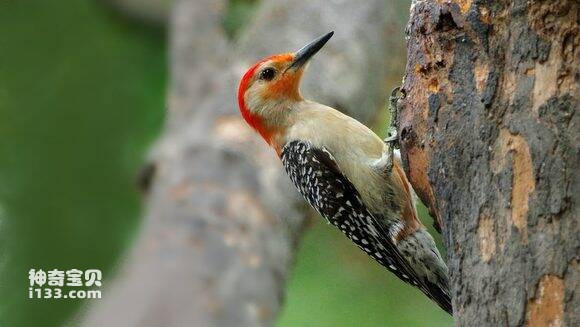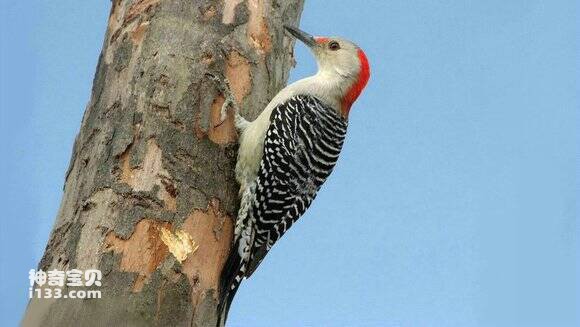Melanerpes carolinus
IUCN
LCBasic Information
Scientific classification
- name:Melanerpes carolinus
- Scientific Name:Melanerpes carolinus,Red-bellied Woodpecker
- Outline:Climbing birds
- Family:
Vital signs
- length:About 24 cm
- Weight:56-90g
- lifetime:No textual research information is available
Feature
Distribution and Habitat
The red-bellied woodpecker is found in southeastern North America, Canada, Mexico, and the United States.
In the United States, the Dakotas, Minnesota, Wisconsin, Ontario, Massachusetts, along the rivers of Missouri to Platte, South Dakota, the western Colorado Valley, and south to Texas and Florida.
The red-bellied woodpecker inhabits lowland swamp forests, open areas of wetlands, with mixed deciduous and conifer plantations of very large walnut trees. It also occurs in dense forests, along or near river beds of small streams, oaks and elms. Frequent visits to neighbourhoods with shady trees and areas with dead trees. It lives 600 meters above sea level and can reach 900 meters in some areas.
Appearance
The red-bellied woodpecker is 24 cm long; Wingspan 33 to 42 cm; Weighing 56 to 90 grams, it is a small and medium-sized climber with strong feet and 4 toes, of which 2 are forward and 2 are backward. The toe ends of each toe are equipped with sharp claws, which makes it good at climbing trees. The stem of the tail feathers is stiff like a spine, and can support the tree trunk with its tips, helping the feet to support the weight and climb the tree. The mouth is as stiff as a chisel. The tongue is slender and can be stretched freely, with short hooks at the tip. The top and neck of the male bird is bright red, and the female bird usually has a gray top cap. The wings have strong black and white plumage and white rump. The central tail feathers are predominantly white with some black stripes. The outer tail feathers are black and white, and the abdomen is covered with a red patch that does not always come out. In flight, white streaks can be clearly seen on the primary flight feathers. T
Details
The Red-bellied Woodpecker is Melanerpes carolinus and red-bellied Woodpecker, no subspecies.
Red-bellied woodpeckers prefer to vary their living areas, rather than living on different levels of the same tree. And the amount of woodpecker living areas superimposed, however, the territories of the two species, while overlapping, do not necessarily conflict, and the territories of the rival European starling remain strictly separate, mainly because the food is both borers.
When climbing for food, he taps the tree with his mouth, tapping very fast, with a frequency of 15-16 times per second. The skull is very strong, and the brain is surrounded by a layer of spongy bone containing fluid, which acts as a buffer and shock absorber. There are also shock-absorbing muscles around the skull that keep the tip of the beak and head in line at all times. Chisel tree holes to build nests every year, eat insects and grubs under the bark, such as longan larvae, gidding insects, etc., play an important role in the prevention and control of forest pests.

Diversified diet, partly eat vegetables, the proportion of food in spring and winter accounted for more than 80%, usually accounted for nearly 40%. The most common are insects, including ants, flies, locusts, beetle larvae, caterpillars, but also catch spiders and larger prey such as tree frogs, lizards, eggs and other broods of small birds. Fruits (apples, peaches, oranges) and berries (mainly blackberries) are also eaten. Seeds and nuts are the most important part of the winter diet. Food stocks include nuts, pecans, hazelnuts and conifer seeds. In some areas.
Breeding period from March to August. At the end of March, he began to estrus, during which he often struck the tree trunk violently with his mouth, issuing a 'Gong Gong... 'continuous sound, used to lure the opposite sex. Sometimes three birds (two males and one female) are also seen fighting together for a couple, stirring each other up and down, flying and calling until the other male is driven away. Nest in the tree hole, the nest hole is mostly chosen in the heart has decayed broad-leaved tree trunk, sometimes also in the thick side branches. It's made by both male and female birds. New holes every year, not old nests. Each nest hole takes about 15 days to complete. The height of the nest hole from the ground is mostly 2-18 meters, sometimes as high as more than 10 meters and as low as 2 meters. The hole is round, the diameter is 4.5-4.6 cm, the inner diameter of the hole is 8.5-10 cm, and the depth of the hole is 18-28 cm. There are no upholstery inside the nest, only a few wood chips. The eggs are white, oval, smooth and unspotted, 22-27 mm ×16-21 mm in size. The male and female incubate the eggs in turn, and the incubation period is 12 days. The chicks are late sex, and the whole body is naked and featherless after hatching, and the flesh is red. Both male and female birds raise chicks together, and after 20-23 days of feeding, the chicks can leave the nest and fly.
Listed on the International Union for Conservation of Nature (IUCN) 2013 Red List of Threatened Species ver 3.1 - Not Threatened (LC).
Protect wild animals and eliminate wild meat.
Maintaining ecological balance is everyone's responsibility!








